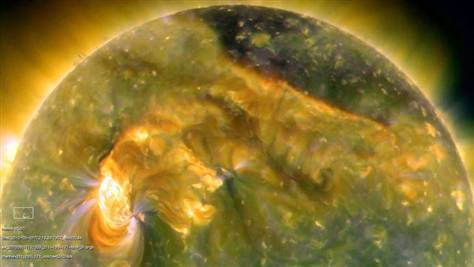Amazingly fast eruption on the sun photographed
Source: msnbc.msn.com
One of the fastest big solar eruptions in years has been observed streaking away from the sun at more than 2.2 million mph by two NASA spacecraft.The flare occurred Aug. 1 and created a massive sun eruption called a coronal mass ejection that struck Earth’s magnetic field Tuesday, creating dazzling aurora displays. NASA’s twin STEREO spacecraft recorded the eruption and beamed images of the sun storm back to Earth.

The material ejected from the sun was seen speeding toward Earth at more than 1,000 kilometers per second, or just over 2.2 million mph. Another wave from the event was expected to hit Earth’s magnetic field on Wednesday. NASA’s two STEREO spacecraft, which monitor the sun’s weather in 3-D, also recorded a video of the sun eruption.
"These kinds of eruptions are one of the first signs that the sun is waking up and heading toward another solar maximum expected in the 2013 time frame," NASA officials said in a statement. The sun goes through a regular 11-year activity cycle. The last solar maximum occurred in 2001 and its recent extreme solar minimum was particularly weak and long-lasting, the space agency added.
NASA SDO - Filament Eruption and Solar Flare, August 1, 2010
Video from: YouTube.com
Coronal mass ejections are eruptions of charged particles from the sun that stream out over several hours. They can contain several billion tons of plasma and expand away from the sun at speeds of up to 1 million mph. At such speeds, they can cross the 93 million-mile gulf between the Earth and sun in two to four days.
The material belched from the sun during the Aug. 1 flare is not expected to cause any disturbances on Earth other than creating spectacular auroras. Auroras are created when charged particles are caught by Earth’s magnetic field and interact with the atmosphere above the poles.
The Aug. 1 solar flare was a moderate C-class flare. The coronal mass ejection it set off created a strong so-called geomagnetic storm that lasted nearly 12 hours enough time for auroras to spread from Europe to North America, NASA officials said in a statement.
Stronger solar storms could cause adverse impacts to space-based assets and technological infrastructure on Earth.
Article from: msnbc.msn.com






















